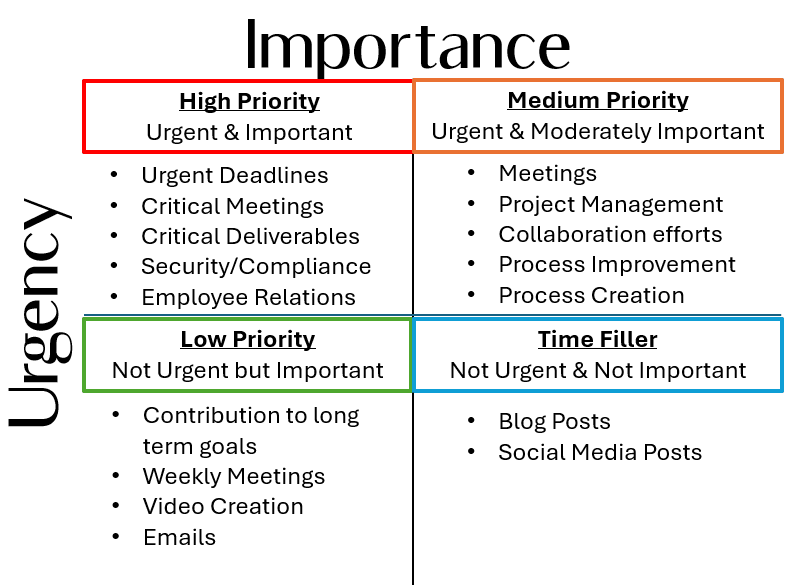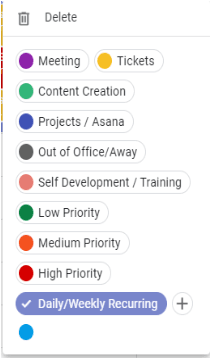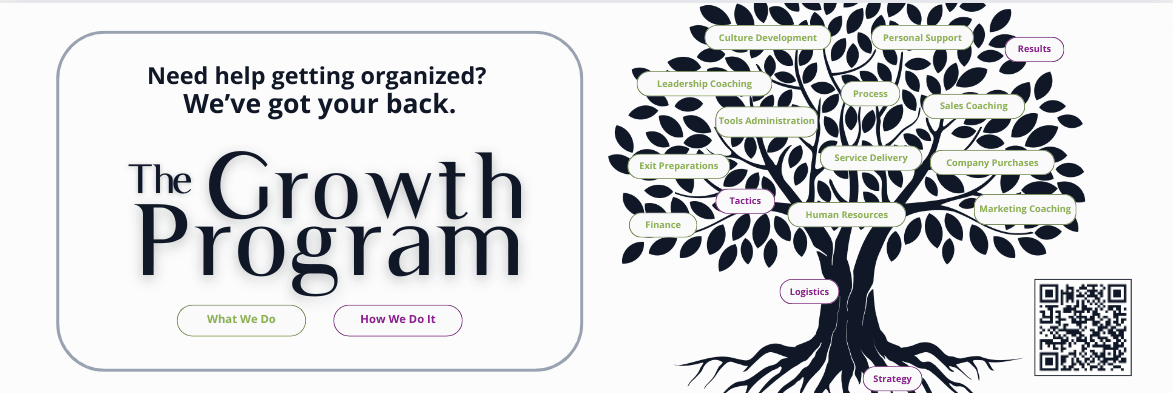
The Visionary Lens: The Leadership Superpower That Sees What’s Next
In today’s fast-paced world, where demands constantly tug at our attention, mastering productivity and prioritization has become more crucial than ever. The ability to navigate through an ever-growing list of tasks efficiently can mean the difference between success and overwhelming chaos. Yet, despite the importance of these skills, many find themselves struggling to juggle competing priorities and deadlines. Struggling with productivity and prioritization isn’t your fault. The sad truth is that no one teaches you how to prioritize, how to juggle competing priorities, or how to be productive. Let’s take a look at some of the strategies to help streamline workflows, manage your to-do list and regain control of your time management.
The first step in regaining control over your tasks is to consolidate them into a single, centralized location. Scatterbrain is the enemy of productivity, and having tasks strewn across various platforms only adds to the confusion. By consolidating your tasks, whether through a dedicated task management app or a simple digital document, you create a clear and organized space where all your responsibilities reside. This not only reduces the risk of overlooking or losing sight of important tasks but also provides a comprehensive overview of your workload.
If you’re already using a task management app, take advantage of its integrations to streamline task consolidation further. Many apps offer integrations with popular tools like calendars, emails, and communication platforms, allowing you to sync tasks seamlessly across different tools despite where the task originated. By harnessing the power of integrations, you can ensure that all your tasks are synchronized and up-to-date, eliminating the need to switch between multiple apps and reducing the risk of missing deadlines.
Once you’ve consolidated your task list, the next step is to prioritize your tasks effectively. Not all tasks are created equal. Attempting to tackle them in random order can lead to inefficiency, frustration, and missed deadlines. One popular framework for prioritization is the Eisenhower Matrix, which categorizes tasks based on their urgency and importance.

At the top of the matrix are tasks that are both urgent and important—these are your high-priority tasks that require immediate attention. These could be deadlines, important meetings, or critical deliverables that cannot be delayed. Next are tasks that are urgent but not important. These are your medium-priority tasks that require your attention. Due to the urgency of these tasks, it’s important these are scheduled to be completed prior to their deadline. These could be meetings, project management tasks, or collaboration efforts. Some may choose to delegate these tasks, especially if you are unable to meet the required deadline and they do not require your specific skill set. Then come tasks that are not urgent but important—these are your low-priority tasks that contribute to long-term goals but can be scheduled flexibly. Finally, there are tasks that are neither urgent nor important. The Eisenhower matrix dictates that these tasks should be deleted. I, however, disagree. These tasks made the list because you deemed them necessary to complete. These are your time-filler tasks that can be tackled during downtime or delegated to others. I know what you’re thinking, who has down time? Consider using time between meetings or other scheduled tasks to complete these. Whenever possible, these tasks should be delegated and given a due date.
When prioritizing tasks, it’s essential to assess their relative importance and urgency objectively. While some tasks may seem urgent due to external pressures or deadlines, it’s crucial to differentiate between true priorities and mere distractions. Seeking guidance from managers or colleagues can also provide valuable insights into the relative importance of competing tasks, helping you make more informed decisions about where to focus your time and energy.
Once you’ve prioritized your tasks, the next step is to integrate your task list with your calendar to create a structured schedule. Your calendar serves as a roadmap for your day, guiding you through your tasks and appointments with clarity and purpose. By merging your task list with your calendar, you can ensure that your time is allocated efficiently and that no important tasks slip through the cracks. Most integrations will only show you the task name and will likely link back to the task itself for details. When creating tasks, ensure the summary is descriptive, especially if the due date is scheduled a few months out. The important thing to remember is that the task itself is on your calendar to complete. The details of the task can be looked up if they are not brought over to the task itself.
(I recently made a guide to color-coding your calendar; read the guide OR, if you’re a visual learner, watch the video.)

One effective strategy for integrating your task list with your calendar is to employ color coding to visually differentiate task priorities. For example, you could use red to represent high-priority tasks, orange for medium-priority tasks, green for low-priority tasks, and blue for time-filler tasks. By color coding your calendar, you create a visual cue that makes it easy to identify task priorities at a glance, allowing you to focus your attention on the most important tasks first.
In addition to color coding, it’s also helpful to label your calendar entries with descriptive titles that provide context about each task. This ensures that you have a clear understanding of what needs to be done and why it’s important, helping you stay focused and motivated throughout the day. By integrating your task list with your calendar in this way, you create a seamless workflow that maximizes productivity and minimizes distractions.
To maintain a consistent level of productivity, it’s essential to follow a structured approach to scheduling your tasks and meetings. One effective strategy is the 80/60/40 rule, which involves allocating a specific percentage of your calendar to tasks and meetings each day, depending on their urgency and importance.
According to the 80/60/40 rule, you should aim to fill 80% of your calendar today with tasks and meetings, leaving the remaining 20% for breaks and unexpected interruptions. Assuming you are working an 8 hour workday, this is equivalent to scheduling 6.5 hours. This allows you to allocate sufficient time to tackle your high-priority tasks while also providing flexibility to accommodate unforeseen changes or delays
Similarly, you should aim to fill 60% (4.75 hours) of tomorrow’s calendar with tasks and meetings, leaving 40% for flexibility and contingency planning. This ensures that you have a clear plan of action for the following day while also allowing room for adjustments based on your progress and priorities.
Finally, you should aim to fill 40% (3.25 hours) of your calendar two to five days out with tasks, leaving 60% for flexibility and long-term planning. This allows you to allocate time for tasks that may not be immediately urgent but are important for achieving your long-term goals, such as strategic planning or professional development.
In addition to following the 80/60/40 rule, it’s also helpful to maintain a list of tasks on deck for flexible utilization. Ideally these are “Time-filler” tasks. These are tasks that can be tackled during downtime or used to fill gaps in your schedule when unexpected changes occur. By keeping a list of tasks on deck, you ensure that your time is always productive and that no opportunity goes to waste.
One of the most powerful tools for driving action and accountability is the assignment of deadlines. Deadlines create a sense of urgency and momentum, motivating you to prioritize tasks and take action to meet your goals. It’s essential to assign deadlines strategically to ensure that tasks are completed efficiently and effectively.
Even low-priority and time-filler tasks benefit from having deadlines assigned to them. A task with no deadline may never be completed. While these tasks may not be as urgent or important as others, assigning deadlines ensures that they receive the attention they deserve and prevents them from being neglected or forgotten. Additionally, assigning deadlines to low-priority and time-filler tasks helps you manage your workload more effectively by spreading tasks out over time and preventing last-minute rushes. The deadlines on these tasks can be flexible but it’s important that they aren’t continuously “kicked down the road”.
When assigning deadlines, it’s important to be realistic and considerate of your workload and priorities. Avoid overloading yourself with unrealistic deadlines that create unnecessary stress and pressure. Instead, aim to schedule tasks to be completed the week before they are due, allowing for flexibility and buffer time to accommodate unexpected changes or delays.
Mastering productivity and prioritization is a journey of continuous improvement that requires dedication, discipline, and a willingness to adapt. By implementing the strategies outlined in this guide, you can streamline your workflow, conquer your to-do list, and reclaim control over your time. Remember, productivity is not about doing more but doing what truly matters. So, take charge of your time, prioritize wisely, and watch your productivity soar.
